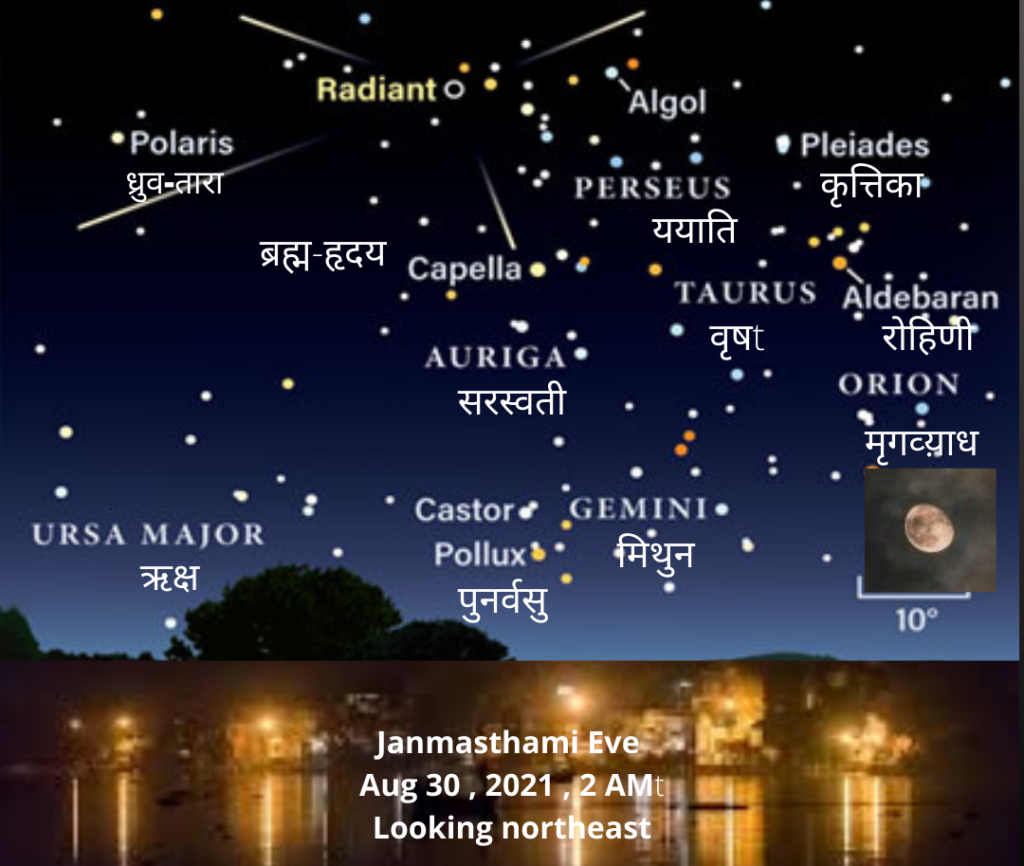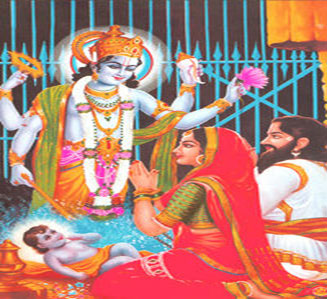
Abstract: The tradition of celebrating the birthday of Shri Krishna as the festival of Janmashtami is found in the Puranas. Krishna was born at the midnight hour of the 8th tithi (date) of the dark fortnight of the Bhadrapada (August-September) when the Sun was in Simha (Leo), waxing Moon in Vrisha (Taurus) and the Moon’s ascendant star was Rohini (alpha-Tauri). Our Panchangam (Vedic calendar) is lunar besides being sideral. The Samkranti (transition of Sun in the zodiac in 12 months, each of 30 days) is calculated with respect to the Sun’s relative position to Earth. On the other hand, the 30 dates in a lunar month of Panchangam are calculated according to the position of the Moon in its orbit. The 30 dates correspond to 14 each of the waxing and waning phases of Moon besides the full moon (purnima) and the new moon (amavasya). However, the revolution period of Moon being less than 30 days, the tithis will not fall on the same orbital position of the Moon every year. This will add variation to Gregorian dates which will go on advancing and it is adjusted by adding a adhi-masa (leap-month) roughly every two and a half years. There is another reference system of calculating Moon’s position with respect to 27 nakshatra (stars): the time, which the Moon requires to travel over the 27th part of the ecliptic, is called ‘nakshatra’ and the one which is closest to the Moon on its path, is called Moon’s Nakshatra. The same anomaly exists here due to the difference in the number of dates and ecliptic divisions-the nakshatras will not fall on the same orbital position of the Moon (tithi) every year. Thus, every 19 years the tithi and nakshatra match; however, if day and time are also taken into account, the coincidence may take even longer.
Therefore, in the context of Janmashtami, the orbital position of the 8th phase of waxing moon and the ascendency of Rohini star will be at variance in different years. The exact celestial position of the Moon and stars which is described at the time of Shri Krishna’s birth will be therefore, occurring at the interval of many years. The rare combination of Ashtami Tithi and Rohini Nakshatra forms the Jayanti Yoga. And this time, as per calculations of astrology, after 10 long decades (101 years), Jayanti Yoga occurs on the midnight of Monday, the 30th of August, 2021.
The Panchangam for August 30, 2021 fulfils the six criteria which together call for celebrating Janmashtami day as Jayanti. These are:
- Luni-solar month: Bhadrapada in the purnima-ending system; (amavasya-ending month will be called Shravana); Sun in Leo;
- Date: Krishna Paksha Ashtami; the 8th of dark half; since the time of sunrise 6:12 AM and until 2:00 AM on August 31, 2021.
- Midnight phase of Moon: Ashtami (waxing gibbous phase of Moon); Moonrise at 11:35 PM
- Lunar mansion: (640 ENE) near Rohini (Aldebaran or Alpha-Tauri) and it passes by Ardra (Betelgeuse or Alpha-Ori) later in the night.
- Period of Rohini star: Rohini rises at 6:39 AM on August 30,2021 and lasts whole day and night until 9:44 AM on August 31, 2021.
- Day: Monday (a sarvartha siddhi yoga exists whole day, being so called since Rohini and Monday are conjoined. In Vedic system the day changes with sunrise.)
The special celestial event when the Ashtami Moon is conjoined to Rohini at the midnight hour during the dark fortnight of Bhadrapada month is called a ‘Jayanti’. It is very unusual for Ashtami tithi, Rohini nakshatra and Monday to converge and that too, on a particular time . This tradition is also mentioned in the Puranas; especially the later ones. Several of the medieval works have borrowed it from the Bhavisya, Bhavishyottara, Skanda, Visnudharmottara, and Brahmavaivarta Puranas. This tradition evolved gradually as evident from the study of the relevant passages on Krishna’s birth in the four Vaishnava Puranas:
The Vishnu Purana (Pt V Sec 3 verses 3-4;7; 15; 17) goes on to say: On the day of his birth, all the quarters were lighted up with joy and it gave delight to all people like unto the rays of the moon. The pious obtained new delight; the strong wind was pacified and the river flowed silently when Janardana was about to be born. At midnight, when the supporter of all, Janardana was going to be born (ardharAtre akhilAdhAre jAyamAne JanArdane), the clouds began to roar in low sounds and pour down rain (of flowers). Vasudeva, taking the babe, went out the same night. It was raining heavily at that time and the many headed serpent Shesha followed Vasudeva spreading his hoods above their heads.
The Bhagavata Purana (X canto Ch.3 verse 1-2; 4; 7-8; 49-50) goes on to say: The time was endowed with all good characteristics and was very pleasant, along with the star governed by Prajapati Brahma (being the Rohini nakshatra i.e. Aldebaran or Alpha-Tauri ) all the celestial constellations, planets and stars were tranquil. That the quarters looked very clear and the sky was lit up by bright stars (not moon; that being a dark fortnight!), … the wind that blew was very pleasing to the skin and laden with fine fragrance… that the water laden clouds following the oceans (the monsoon clouds) began to roar in a low bass… Janärdana being born in the midnight that was enveloped by darkness… Vishnu, the dweller of every heart, was brought forth by goddess Devaki, as if the full moon rose in the East. (When Vasudeva went out with the babe), the clouds with gentle roar were pouring rain ; thereby, prompting Shesha to thwart the downpour with his hoods. That being the season of frequent raining caused rising of Yamuna waters with deep torrents, spuming currents and hundreds of awe-inspiring swirls in the river.
The above description from the two most respected Vaishnava Puranas suggests that Shri Krishna was born at the midnight during the rainy season. The sky was clear until the time of his incarnation and it was followed by a heavy downpour. That day Rohini was seen in the sky.
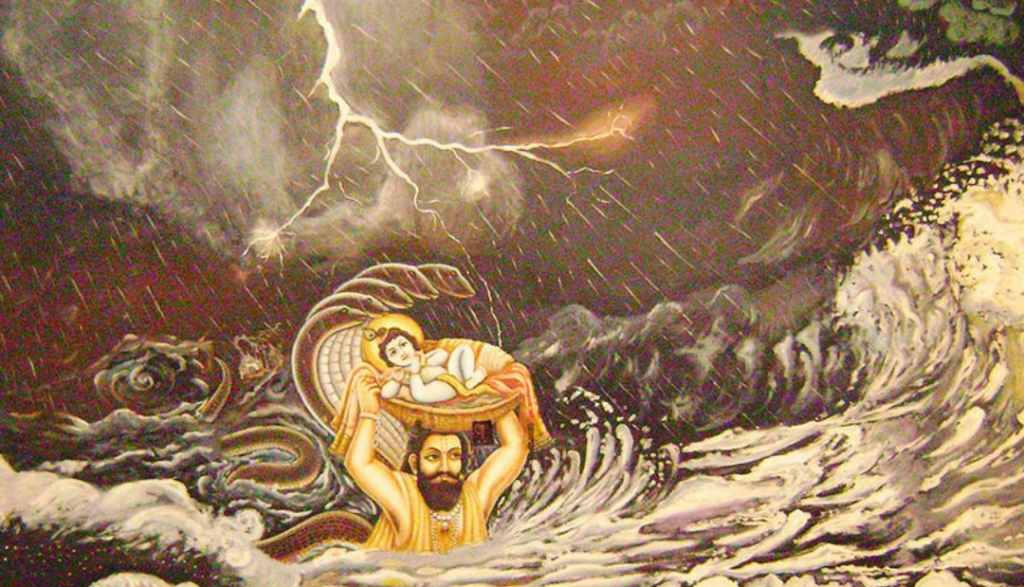
The Naradiya Purana (Purva Bhaga Chapter 117 on Ashtami fasts) goes on to say that the Ashtami of the dark fortnight in the month of Bhadrapada should be observed as a ten day ritual involving fasting and worship of Lord Krishna with ten Tulasi (holy basil) leaves respectively offered for the ten names of Krishna, Vishnu, Ananta, Govinda, Garudadhwaja, Damodara, Hrishikesha, Padmanabha, Hari, and Prabhu followed by a fire homa, acharya puja, feeding and donation (Verse 15-26). Narada Purans further explains the special puja precept for Krishna Janmasthami (Verse 27-40). It declares that just fasting on the birthday of Shri Krishna destroys the sins of seven lives. The precept of worship of Shri Krishna is such that a golden idol of Shri Krishna, along with Devaki -Vasudeva- Yashoda Nanda- Vraja- Gopa- Gopi- and cows in a mandala (circle) is to be placed in an arbour and honoured by Puja-upacharas. In the midnight again the devotee should bathe Hari with Panchamrita and pure water and repeat the puja with offering of fragrance, etc. Naivedyam made of rice, barley, dry ginger and sugar with ghee be offered on a silver platter, to be followed by Arati, meditation on the ten forms of Krishna, offering libation to moon, and waking for the rest of the night while reciting the Puranic Stotras, singing and playing of instruments, etc. Next morning Brahmins should be fed and offered donations and only thereafter one should break the fast.
Padma Purana, the last in the quartet of the Vaishnava Puranas, describes the precept of worship of Hari in different months (in the Patala Khanda Chapter 80, verse 27): the Vaishanava should be intent on a fast on Birthday in Bhadrapada. (bhadrAye cha janmadivasa upavasaH aparo bhavet). Further, the observation of Jayanti is described (Uttara Khanda Chapter 31, Verse 32-33): “If in the month of Shravana (Bhadrapada in the month ending with full moon) on the 8th of the dark half Rohini is seen (in the sky) then that day is named Jayanti.”
The precept of celebration includes fasting and installation of the golden image of Yashoda suckling babe Krishna and the golden and silver images respectively of Rohini and Chandra. One should bathe the image of Vishnu along with his mother with milk, etc. and smear it with sandal, cover with a white garment and garland of flowers, offer eatables and a variety of fruits, light a lamp and decorate with a mandapa of flowers. It is to be followed by singing and dancing and playing on musical instruments for the whole night.
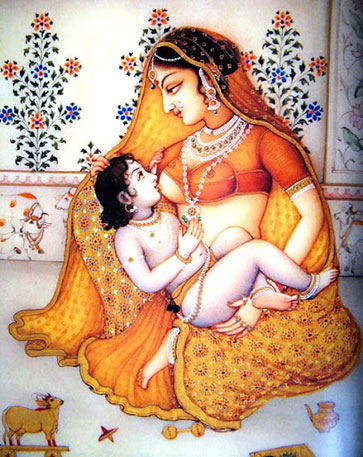
The latter two Puranas aim at enunciating the instructions for fasting and worship on the occasion of Sri Krishna Janmashtami. Padma Purana clearly draws a distinction between the fast observed on Janmadivasa (Janmashtami) and the celebrations on Jayanti (Ashtami conjoined with Rohini nakshatra).
The Agni Purana (Ch 12; verse 6-7) mentions that on the 8th in the dark half of the month of Nabhasa (Vedic name of Bhadrapada ) Krishna appeared in the four-armed form in the hour of midnight. Further the precept of Ahtami Vrata is elaborated upon in the Chapter 183. It goes on to say that ‘ On the midnight of Ashtami conjoined with Rohini nakshatra in the month of Bhadrapada, Krishna was born and hence this Ashtami is called his Jayanti. Fasting on this Ashtami of the dark half of Bhadrapada conjoined with Rohini destroys the sins of seven previous births. (Verses 1-3). The precept of Jayanti celebration is same as that given in the Padma Purana and Naradiya Purana and it involves worship of Krishna and also Moon and Rohini, including the midnight pooja ritual.
The Garuda Purana (Chapter 112) goes on to say that the worship of Hari should be done in the midnight of the Ashtami of the dark fortnight with Rohini nakshatra; (the latter being preferable ) even if the Ashtami is combined with Saptami (at the time of sunrise) as it destroys the sins of three lives.कृष्णाष्टम्यां च रोहिण्यां अर्द्धरात्रिsर्चनम् हरेः…….
This distinction between Janmashtami and Jayanti, as evident in Padma Purana, was highlighted in other Puranas also. In the Bhavishya Purana (Uttara Khanda Ch. 44.14-15 Nag Publishers ed.) Krishna himself is represented as narrating to Yudhishthira the incidents of Janmashtami-vrata:
‘When the Sun was in Lion (Leo) and the sky was cast under clouds, on the 8th of Bhadrapada dark half at midnight with the Moon in the sign of the Bull (Taurus) and Rohini nakshatra conjoined, I was born of Vasudeva and Devaki and therefore this being celebrated in the world as Janmashtami-vrata’.
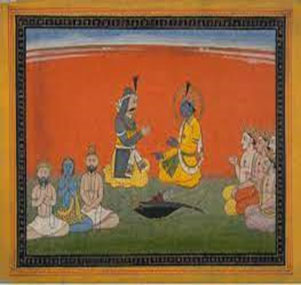
In his monumental work on ‘History of Dharmashastras’ Dr. PV Kane has dealt with the topic of Jayanti and Janmashtami in great detail. The Bombay edition of Bhavishya Purana is quoted by him: ‘when on the 8th of the dark half of Shravana (in the month ending in new moon) there is Rohini-nakshatra, the tithi is called Jayanti; if a man observes a fast on that tithi, that destroys his sins committed in childhood, youth, old age and many previous lives’. The quotations from Bhavishya Purana, Brahma Vaivarta Purana, Skanda Purana, Vishnu dharmottara Purana, etc. have been relied upon in the medieval works such as Rajamartanda of King Bhoja (11th century), Chaturvarga Chintamani of Hemadri (13th Century), Madhavacharya’s Kaal Nirnaya (14th Century), Varsha Kriya Kaumudi of Govindananda (16th century), Tithi-tattva of Raghunandan Bhattacharya (16th Century), Nirnayasindhu of Kamlakara Bhatta (17th Century), etc. to distinguish between the two celebrations.
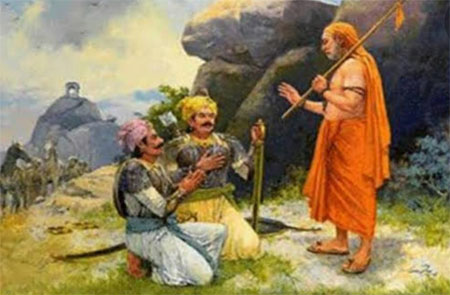
Shri Madhvacharya, the great commentator on Smritis and a proponent of Advaita school of Indian philosophy and the Acharya of the founder rayas of Vijayanagar Empire in the 14th Century, has perhaps given the most detailed instructions on the fasting and celebrations on the occasion of Shri Krishna’s birthday. The important question is whether the Janmashtami-vrata and Jayanti-vrata are really only one vrata or whether they are two separate vratas was decided by him in the Kalanirnaya,by applying Mimamsa principles of Jaimini, and he concluded that the two are separate vratas on the grounds that the two names are different (viz. Janmashtami-vrata and Jayantivrata), their occasions (nimitta) are different (the first depends only on dark Ashtami while the latter exists only if there is Rohini on 8th of dark half of Sravana) and their characteristics are different in that in Janmashtami-vrata only a fast is required, while in Jayantivrata the and Jayantivrata besides a fast, an elaborate pooja and also gifts and the like are required. Shri Madhvacharya, while relying upon Vishnu Dharmottara Purana, has also declared that If Jayanti fast, occurs on Wednesday or Monday there are for greater results and such a fast is superior to crores of other vratas and the man who observes a fast on Jayanti conjoined to Wednesday or Monday would not be born again. Brahma Vaivarta Purana and Padma Purana also speak of the coincidence of a Monday or Wednesday on Ashtami to be very auspicious. Monday reminds the descent of Shri Krishna in the lunar dynasty and Wednesday, being regarded as the son of Moon and Rohini.
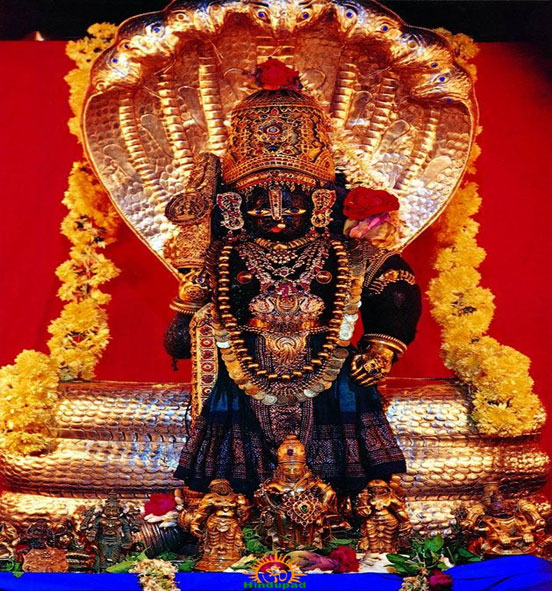
Most scholars, Like Madhava, also find the two occasions to be different; however, adherence to nakshatra-system is more emphasized upon by the works that belong to South India whereas the date is more important a criterion in the North. It can be safely concluded that fasting and celebrations are made on Janmashtami and Jayanti both; they are equally sacrosanct and held to be obligatory observance for all Hindus. Most of these texts and all Puranas point out that the principal time for the celebration of the birth of Shri Krishna is the midnight of the 8th of Bhadrapada dark, if the month is Purnimanta (or Sravana dark half, if the month is Amanta, as popular in Gujarat). This tithi is of two kinds viz. (1) without Rohini nakshatra and (2) with Rohini nakshatra. In Janmshttami-vrata tithi is the principal matter while in Jayanti it is the nakshatra (Rohini) that is principal. Depending upon the period of Ashtami and Rohini, and their conjunction or absence thereof, several permutations-combinations are possible. These depend on the incidence of a pure (shuddha) Ashtami tithi throughout the day and at midnight or its combination (vedha) with either Saptami and/or Navami tithi. Similarly, Rohini nakshatra succeeding to Krittika on Ashtami is a vedha and not desirable.
Tithi-tattva of Raghunandan Bhattacharya (16th Century) has summarised the instructions as under:
If Jayanti with Rohini exists only a single day, the fast must be observed on that very day;
If it spreads over two days, then the fast is on the later of the two;
If there is no Jayanti, then the fast is to be observed on Ashtami joined with Rohini;
If two days have Ashtami joined to Rohini, then fast is to be observed on the later of the two;
If there is no Rohini nakshatra, then fast is to be observed on the Ashtami that exists atmidnight;
If Ashtami exists on two days at midnight or if it starts after midnight of the first day then on the later day.
Now, it is clear that the celestial position on 30 August, 2021 falls in the last category. The phase of Ashtami started on 11:25 PM on August 29, 2021; it exists whole day and night on August 30, 2021 until the Navami begins on 2:00 AM on August 31, 2021. Rohini nakshatra rises at 6:39 AM on August 30, 2021 and lasts whole day and night until 9:44 AM on August 3, 2021. Therefore, on the midnight of 30 August, 2021 Ashtami (waxing gibbous of Moon) is conjoined to Rohini Nakshatra (Aldebaran or Alpha-Tauri) and hence, it is a Jayanti. Moreover, it falls on Monday and hence, today is the most auspicious celestial event to celebrate Sri Krishna’s Birthday. It is somewhat close to what could have been the position 5252 years ago, what Hindus believe to be the date and time of incarnation of Shri Krishna in the Dvapara Yuga. Shri Krishna was born on the Krishna Paksha Ashtami of Bhadrapada, while Sun was in transit through the sign of Lion (Leo), and as the moon rose at midnight, coinciding with the sign of Bull (Taurus) in the zodiac, the star Rohini (within the constellation of Taurus) was sighted near the moon in the North-Eastern sky along with the Great Bear. Just to have a look of the August sky below and to feel what Sage Shuka sighted what he told in the Bhagvata Purana:
“अथ सर्वगुणोपेतः कालः परमशोभनः। यर्ह्येवाजनजन्मर्क्षं शान्तर्क्षग्रहतारकम्।।दिशः प्रसेदुर्गगनं निर्मलोडुगमोदयम्…”–The time was endowed with all good characteristics and was very pleasant, along with the star governed by Prajapati, all the celestial constellations, planets and stars were tranquil. That the quarters looked very clear and the sky was lit up by bright stars!!
